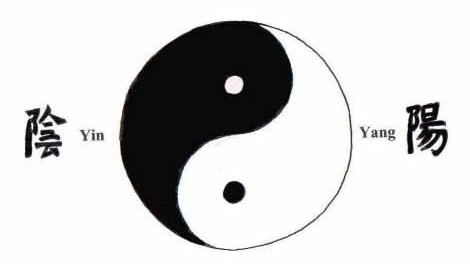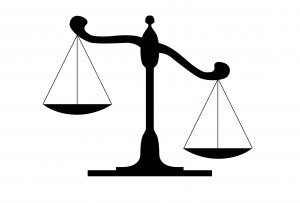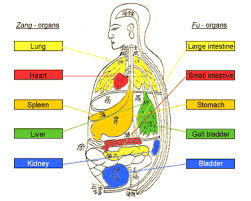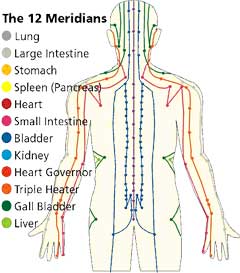Yin and Yang
The Yin and Yang theory is an ancient concept used in traditional Chinese medicine (TCM) to identify health problems. The theory can be traced back to as far as 700 B.C. where it was referenced in the I Ching, or The Book of Changes. Yin and Yang are essentially two properties in the universe that are constantly opposing, yet complementing, each other. The constant activity of the properties is what gives rise to change.

In the yin-yang model, the two energies blend into one seamless whole to represent a relationship of harmony. Yin is represented by the color black in the model and contains a “seed” of Yang, which is represented by a white dot. Conversely, Yang is represented by the color white and contains a black “seed” of Yin. The seeds represent the ability of one energy to transform into the other. However, this only takes place under certain conditions, under which the seed can grow. The presence of the seeds within the opposing energy depicts that yin is not only itself, but it is also yang due to the yang energy present within the Yin in the form of a seed and vice versa. The model portrays that these energies are separate, but equal depicting balance in the relationship. This relationship of balance extends to one of harmony because the two energies blend into one seamless whole, which is represented by the swirling in the symbol.

Everything is YIN YANG is everything
Negative Positive
Female Male
Night Day
Passive Active
Moon Sun
Intuitive Logical
Cold Hot
Soft Hard
Death Life
Stillness Movement
Dark Light
Submission Dominance
Weak Strong
Small Big
Hate Love
The Chinese characters for Yin and Yang are very much representative of their meanings and portrayal in the yin-yang model. The Chinese character for Yin represents the shady side of a hill, while the Chinese character for Yang represents the sunny side of a hill. The literal meaning of each character is representative of some of the character’s qualities. Yin is the element of a cycle or process where energy is being accumulated, assimilated, and stored for later use. Yin is often associated with rest, receptivity, and quiet. Yang is the element of a cycle or process where energy is being expended in order to perform an action, or create change. Yang is often associated with action, creativity, and movement. Yin is considered the substance of life and Yang is considered the functional, active aspect of any process or cycle. It is said that the Yin provides sustenance for the Yang and the Yang protects the Yin. Yin and Yang are relative concepts that are both essential to life. Because they are seen as two aspects of the same thing, they are often referred to as two sides of the same coin.
A Balancing Act

The yin and yang energies are opposing forces that compete for dominance, but they do, however, remain complementary, acting in harmony with one another. They are able to do this because dominance is never permanent due to the forces’ ability to transform into one another. Through transformation the forces are able to work to restore balance to the whole. However, transformation may only occur under certain conditions (when the seed can grow) that are determined by internal qualities of given situation or phenomenon. As long as the forces remain within their well-defined limits when competing for dominance, the opposing force will be able to recover. Therefore, under normal circumstances, neither force will go to such an extreme that the opposing force will be unable to recover from it.
The yin-yang theory is said to be cyclical in nature. We can observe the cycles that occur through the transformation of energy. For example, if Yang is the dominant force, then it will begin to transform into Yin. This transformation of energy will eventually cause Yin to become the dominant force. Yin will then begin to transform into Yang and Yang will dominate, which will start the cycle all over again. There is no “on/off” button for the transformation of energy. Instead there is a system of self-regulation, which makes for a constant game of tug of war. In order to maintain balance, there is a continuous cycle of the transformation of energy that is regulated by the whole. It is this constant activity and self-regulation that is the basis of all existence and change.
The Yin Yang Theory Applied to Human Physiology
In TCM, yin-yang is used to understand complicated relationships in the body. For example, the characteristics of the left side of the brain can be classified as Yin while the characteristics of the right side of the brain can be classified as Yang. The left side of the brain is associated with logical thinking and characterized by quiet, patience, and being soft-spoken. The right side of the brain is associated with creativity and characterized by loudness, impulsiveness, aggression, and being boastful. When the characteristics of the left and right sides of the brain are compared to those of Yin and Yang, respectively, there is a clear correlation that helps us understand the relationship between both sides.
If yin-yang theory can be applied to human physiology, then our bodies must have a system of self-regulation to prevent one force from dominating the other. The regulatory mechanism of the human body is called homeostasis. Homeostasis works to maintain a balance where the body is able to maintain proper function. An example of homeostasis at work in the human body is body temperature. Our bodies must maintain a temperature of approximately 98.6°F (37°C) to maintain proper functions. If body temperature becomes too high or too low, then that is an indication that something is wrong. If left untreated, abnormal body temperature can lead to hypothermia and cause organs to stop functioning, which can be life threatening.
The mechanism of homeostasis has developed in humans through evolution making us innately self-regulatory. Every system and function in the body has its own self-regulatory mechanism built-in to maintain balance. When yin-yang is out of balance, unique physiological functions are exhibited to express certain disorders. In TCM, there are certain symptoms that can be identified that correlate with the imbalance of a system. TCM practitioners are able to identify these functions, allowing them to accurately diagnose the system in which the problem resides. For example, when there is disharmony in the stomach, symptoms that may be exhibited are dry mouth, thirst, nausea, and/or vomiting. In order to restore balance to the body we can nurture our innate self-regulatory systems.
Yin and Yang Organs

In TCM problems that arise in yin or yang organs are considered to be more serious than problems concerning other organs. Disorders in yin or yang organs may be due to the organ itself or it may be caused by a disturbance in the relationship between the organs. Yin organs are located deep within the body and are associated with the manufacturing, storage, and regulation of fundamental substances. Conversely, Yang organs function to receive, separate, distribute, and excrete body substances. Yang organs are hollow and considered to be external. The specified Yin organs, also known as Zang organs, are the lungs, heart, spleen, liver, and kidneys. The Yang organs, or Fu organs, are the large intestine, small intestine, stomach, gallbladder, and bladder. There is, however, an additional Yang organ that is not recognized as an “organ” and has no corresponding structure in Western medicine. This sixth organ is called the triple burner, which is primarily energetic and viewed as the pathway of fluid and heat throughout the body. The relationships between the Yin and Yang organs can be identified by the corresponding colors in the image above.
The Four States of Imbalance
It was previously mentioned how the forces of yin and yang energy remain within their limits when competing for dominance, but what happens when they go beyond those limits? When Yin and Yang are out of balance they become separate forces. Upon separation, the dominant force will consume the other force, causing it to exceed its limits. When an energy force exceeds the limits it inhibits the self-regulatory mechanism. Therefore, balance cannot be fully restored because energy cannot be transformed to promote recovery. The inhibition of the self-regulatory system could result in the system’s breakdown, which could be detrimental to the wellbeing of the whole, especially when applied to human physiology. Regarding the imbalance of Yin and Yang, there are four possible states that one may encounter. The four states of imbalance are listed below with some basic symptoms.
- Excess of Yin
– Sensitive to cold
– Poor circulation
– Pale pink or purpleish/blueish tongue, possibly swollen
– Profuse thick, white/clear phlegm
– Decreased appetite
– Abdominal pain
– Lethargic, feels groggy after sleep - Excess of Yang
– Sensitive to heat
– Strong, rapid pulse and heart beat
– Red face, eyes, and/or tongue
– Strong cough with phlegm
– Increased appetite and thirst
– Restless, high level of energy
– Trouble sleeping - Deficiency of Yin
– Rapid, weak pulse and heart beat
– Hungry and thirsty, but cannot eat or drink very much
– Red, dry eyes
– Red cheeks, dry skin
– Weak dry cough
– Trouble falling asleep
– Restless, but exhausted - Deficiency of Yang
– Slow, weak pulse
– Pale tongue
– Dark circles around eyes
– Shortness of breath, difficulty breathing
– Decreased appetite and thirst
– Weak/slow digestion, dull/achy abdominal pain
– Loss of energy, desire to sleep
– Very cold, sensitive to cold
In order for Yin and Yang to be balanced, the forces must mutually consume each other, providing the foundation for constant change. Mutual consumption is made possible through the transformation of energy. In the human body, energy is transferred through a system of meridians, which correspond to organs. These meridians function to maintain a balance between yin and yang elements. Therefore, organ function is related to energy condition. There are a total of 12 meridians that make up a web of channels that supply energy to every part of the body. When Yin and Yang are out of balance, it is reflected by the presence of disruption in the transportation of energy.

TCM practitioners are able to determine energy levels through observation, questioning, and touching certain points, otherwise known as acupoints. Acupoints are points that correspond to certain organs or meridians. They are located along the channels of meridians and are the sites through which energy is transported to the body’s surface. Acupoints are used in acupuncture to clear the affected meridians or organs. Aside from acupuncture, disturbances in energy levels can be treated through massage, nutrition, and/or herbs.
Herbs are quite effective in restoring balance to a system. Every herb has a certain affinity for a particular meridian, which acts as a direct pathway to the corresponding yin-yang organs. An example is the herb aconite. Aconite is probably the strongest herb used to treat yang deficiencies. The organs most susceptible to yang deficiencies are the heart, kidney, and spleen. Aconite acts to warm all of the organs and open all of the channels, particularly targeting the heart, kidney, and spleen. We will go into further detail about how aconite enters and passes through the channels in the next blog post. Stay tuned to learn more about using herbs obtain optimal health and wellness.